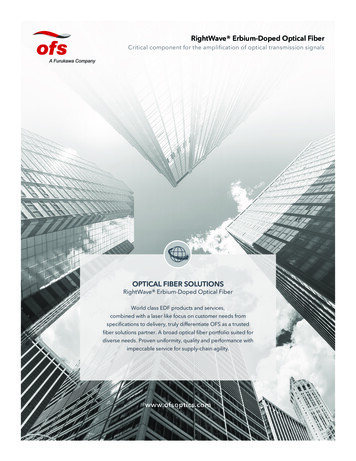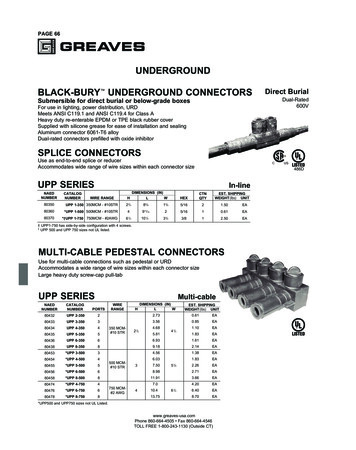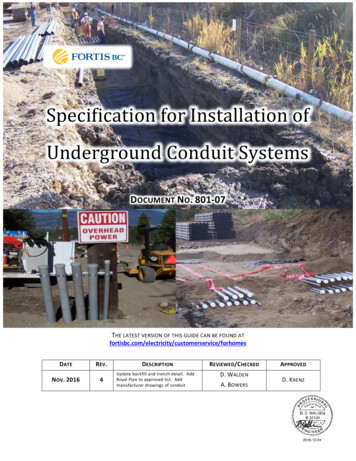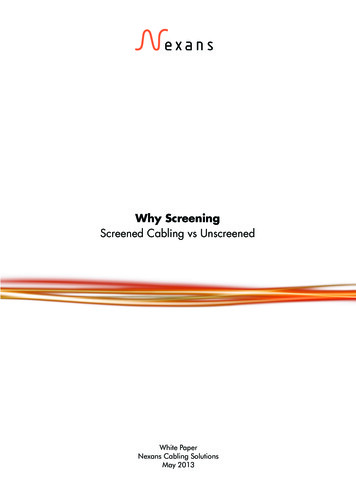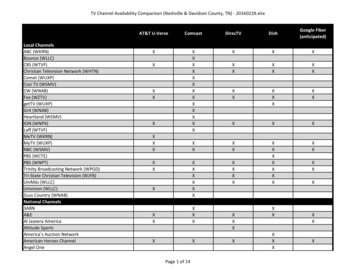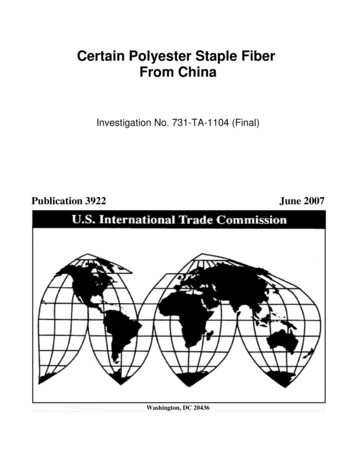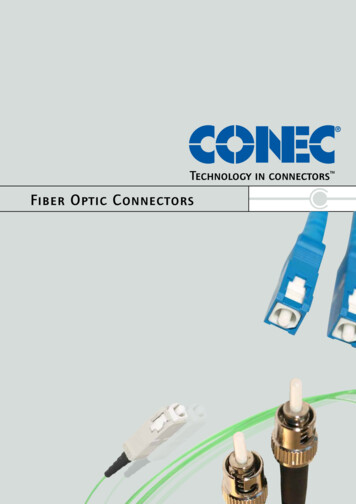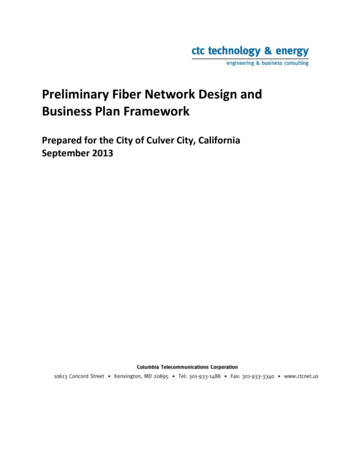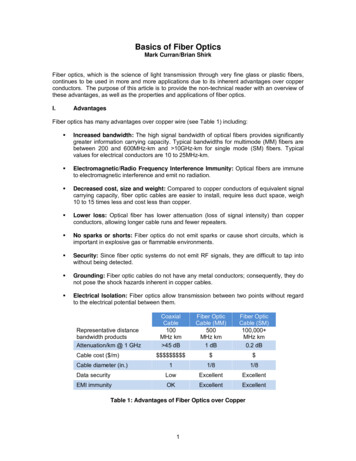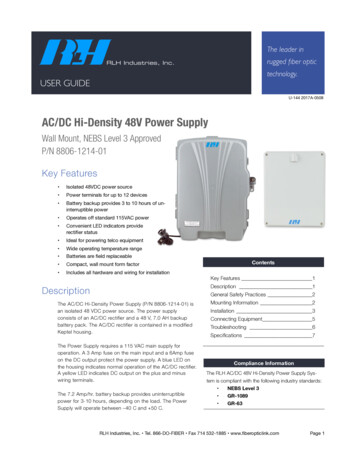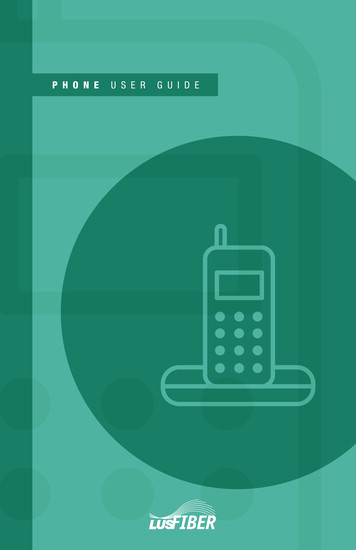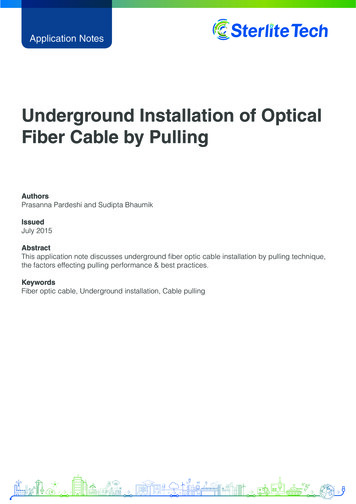
Transcription
Application NotesUnderground Installation of OpticalFiber Cable by PullingAuthorsPrasanna Pardeshi and Sudipta BhaumikIssuedJuly 2015AbstractThis application note discusses underground fiber optic cable installation by pulling technique,the factors effecting pulling performance & best practices.KeywordsFiber optic cable, Underground installation, Cable pulling
IntroductionOptical fiber cables for telecommunication application have been installed in pipes/ducts formany years. The installation process is influenced by local conditions, local climate, customer’sexisting procedures, and customer requirements. There are two basic methods of cableinstallation in a preinstalled duct – Pulling method and Blowing method. The cable installationmethod is selected based on site conditions and availability of machinery & resources. Table 1shows a comparison between the two installation methods.Table 1 Comparison between Pulling and Blowing methodsPulling MethodBlowing MethodPulling rope pre-installedNo pulling rope to installEquipment and manpower at two sidesEquipment and manpower at one sideHigh sidewall forces on cables and ductsmay lead to cable damageForces on cable and duct can bemonitored and controlled and minimalchance of cable damageMainly manual pulling is practiced. Machinepulling needs one hydraulic power packLarge compressor and/or hydraulicpower pack at one sideMainly used for straight duct routePreferred for duct route with multiplebends and undulationsSuitable for short distance (few 100meters) installationPreferred for long distance (over 2 km)installationPulling procedure is necessary and unavoidable in certain areas such as the small areas, smallpatches where blowing set up is not able to be accommodated. In this application note, cableinstallation by pulling method and its best practices are explained.Pulling MethodCable installation into a pre-installed underground ducts/pipes by manual pulling or by pullermachine is called as “Pulling Method”. In this method, cable is pulled through duct/pipes with thehelp of pre-installed rope inside the duct/pipes.Optical fiber Cable pulling in underground horizontal duct routes requires some specialconsiderations. These considerations are familiar to the installers who are specialize in opticalfiber cabling installation, but may be unknown to the contractor who has dealt primarily withcopper cabling. Failing to follow such a procedure can result in fiber/cable damages or highoptical power losses after installation.Optical fiber cable pulling is generally preferred in access networks where underground ducts/pipes are not continuous for more than 200 to 300 meters and cable needs to be stored in coilform at each manhole/handhole available at every 200 to 300 meters.If cables are pulled into conduit or inner duct, the ‘Duct Fill Ratio’ to be maintained below 65%.The ratio between cross sectional area of the cable and inner space of the duct is known as ‘DuctFill Ratio (DFR)’ or ‘Fill Ratio’.
d2DFR 2 x100DWhere,d cable diameterD duct inner diameterCable Pulling Guidelines and Best PracticesDuct Route SurveyConduct the duct route survey and inspect the route for manhole, coiling, splicing locations.Ensure there are no sharp bends or slops that exceed the minimum bend radius of the cable(refer cable supplier specification sheet). Identify and attain the potential problems during routesurvey. Identify the cable reel location/pulling location. Ensure the duct continuity is thorough andclear for the pulling length patch.Pulling RopeEnsure cable pulling rope is available in the duct. If pulling rope is not available inside the ductsthen first install the pulling rope with the help of rodder as shown in Figure1. Push the rodder rodthrough one end of the duct/pipe and as the rodder rod reaches to other end of the duct/pipe, tiethe pulling rope with the rodder rod at other end and reel back the rodder rod.Figure 1 Pulling rope installation by rodderCable Pulling GripCable pulling grip shall be fixed at the head of the cable as shown in below figure 2. The functionof this grip is to provide effective grip over cable sheath which is very useful during cable pulling.A wrap of plastic tape shall be wrapped around the grip which has been pulled tight over thecable.Figure 2 Wire mesh cable pulling grip
Breakaway SwivelIt is strongly recommended to use breakaway swivel during manual pulling installation wherepulling tension is not controlled. During manual pulling, applied pulling tension higher than thecable tensile rating can damage the cable and negatively impact its lifetime. Breakaway swivelsare available with different tensile rating and can be placed in between cable and pulling rope.The main function of breakaway swivel is to break the swivel device if excess tension appliedduring cable pulling. For example, if cable rated tensile is 2700N and breakaway swivel having2500N tensile strength is fixed, when the cable pulling tension goes above 2500N , the swivel willbreak so that excess pulling tension will not have any impact on cable.Pulling RopeFigure 3 SwivelPulling RopeSwivelCable Pulling GripSwivelCable Pulling GripCable reel pay-offThis feature is very important in optical fiber cable installation set-up to ensure cable is smoothlyreel off. It is always recommended to use cable reel pay off during cable installation. The cablereel should be kept in level to avoid cable rubbing against the reel flanges. The cable reelorientation should be such that the natural payoff direction is towards the pulling direction. Toeliminate possible Figurecablecontact with the ground, cablepayout should be from the top of the4Figure 5reel. Figure 4 shows a cable reel in a cable reel pay-off and figure 5 shows the do’s and don’ts ofcable unwinding.Figure 4Figure 4 Cable reel pay-offFigure 5Figure 5Cable HandlingFigure 4All optical fiber cables are sensitive to damage during shipping, handling, and installation. Someof the important parameters that need special attention during cable pulling installation are:Cable bending radius: Optical fiber cables are designed with aminimum bending radius. The cable should never be bent belowits minimum bending radius. Doing so can result in bending lossesand/or fiber breaks in the cable. Generally the minimum bendingradius of a fiber cable under load is 20 D, where D is the diameterof cable.Figure 6
lCable Pulling Tension: Optical fiber cables are designed with a maximum tensile strength.The cable should never be pulled beyond its maximum tensile strength. Exceeding the cable’spulling tension provided by Sterlite in the Cable Data Sheet / Specification, can alter cable andfiber performance and shorten its in-service lifetime.lCable Twist: Cable twist can develop stress on the fibers and therefore need to be avoided.Tension on the cable and pulling ropes can cause cable twisting. Use a swivel pulling eye toconnect the pulling rope to the cable prevents pulling tension causing twisting forces on thecable as shown in figure 3. Unroll the cable off the reel loaded on pay-off or reel jack instead ofmanually taking out as shown in figure 4. When reel-off the cable for pulling, stored in “figure-8”shape on the ground to prevent twisting. The figure 8 puts a half twist in one side of ‘8’ andtakes it out on the other side to prevent generation of twists in cable.Figure 7 Cable stored in ‘fig-8’ shapeCable LubricantsUse of cable lubricants to reduce co-efficient of friction between cable outer surface and ductinner surface is recommended to pull cable in a duct route having multiple bends, elevation andundulations. The lubricant material should not react with cable outer sheath (don’t use soapwater, kerosene, diesel). Apply right quantity of lubricant as suggested by the supplier.For additional information refer Sterlite application note titled “Underground Installation of OpticFiber Cable Placing”(issue- November’ 2014).Copyright 2017 Sterlite Technologies Limited. All rights reserved. The word and design marks set forthherein are trademarks and/or registered trademarks of Sterlite Technologies and/or related affiliates andsubsidiaries. All other trademarks listed herein are the property of their respective owners.www.sterlitetech.com
Cable installation into a pre-installed underground ducts/pipes by manual pulling or by puller machine is called as “Pulling Method”. In this method, cable is pulled through duct/pipes with the help of pre-installed rope inside the duct/pipes. Optical fiber Cable pulling in underground horizontal duct routes requires some special considerations. These considerations are familiar to the .
